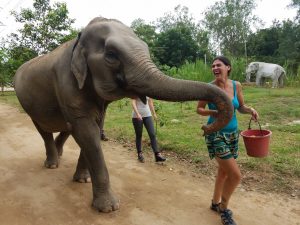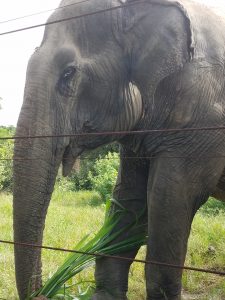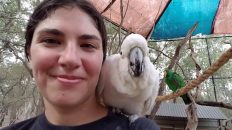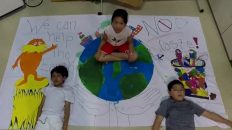In a previous post, and conversations with friends, I have discussed how torn I am about zoos (I can also say this about aquariums). I totally see the benefit – for educational purposes. However, whenever I go to one, I always leave it depressed; I am sad for the animal, because even if they are given some space (many times it is too little), it isn’t their real home.

I was one of those kids who loved touching and learning about animals. Yes, I’ve been to my share of zoos, and circuses. Before volunteering at Wildlife Friends of Thailand, I knew it was bad and had given that up. I didn’t know how much of a dark side there was to the elephant/animal tourism industry. Learning about what goes into the phajaan process, and the continuous abuse afterwards, was heartbreaking. I had no idea that I was unintentionally supporting the crushing of an elephant’s soul – they are one of my favorite animals.
Most people don’t intentionally support this, and it is important that we don’t intentionally ignore it either. I have said before, and will continue to say it – you as a consumer/tourist have purchase power. You buy that ticket to that elephant ride, or tiger petting zoo thing, or circus act – you are saying that you want more of it. So don’t buy into it – don’t support animal cruelty.
But how do you know an activity is bad for the animal? Sometimes, you research. Other times, you go to a place and get that feeling; you stare at a baby alligator, with its face pressed on the wall, not moving. You just know that it isn’t happy to be there. You almost can hear it saying, “I can’t believe this is my life, I want to be free.”
 The above video is a conversation. It first started as me venting, because while I was in Hong Kong with a friend, one of his mates talked to us about his elephant ride. I didn’t really say much – because I was so speechless, and I was in a different country so I didn’t want to blatantly scream or offend someone by walking away. On reflecting, I did realize a few things: 1-that I shouldn’t judge someone because they don’t know what I might know, and 2-I had to learn a better way to express myself when I am faced with a moment like that.
The above video is a conversation. It first started as me venting, because while I was in Hong Kong with a friend, one of his mates talked to us about his elephant ride. I didn’t really say much – because I was so speechless, and I was in a different country so I didn’t want to blatantly scream or offend someone by walking away. On reflecting, I did realize a few things: 1-that I shouldn’t judge someone because they don’t know what I might know, and 2-I had to learn a better way to express myself when I am faced with a moment like that.
And guess what? After that conversation, I got to learn from Wildlife Friends of Thailand about how to be part of the solution! One is spreading the word – aka EDUCATION – about what goes into the animal tourism industry. Another is to voluntour – which is where you volunteer somewhere you visit.
With so many animals becoming vulnerable, endangered, or critically endangered, it is important to learn the right ways to tour and the right ways to treat and learn about animals. We have elephants, sharks, dolphins, whales, polar bears, etc. on our clothing, on murals and paintings in our bedrooms, on food labels, and we as consumers need to be conscious of our actions, and ensure that we keep these beautiful creatures around.
Lesson: What is Animal Cruelty?
Objective: You will define animal cruelty, and discuss solutions and alternatives to activities that may be harmful to the animals involved.
Essential Question/s:
- Have you ever been to a zoo or circus? Did you like it? Why/why not?
- How do you think an animal becomes part of a zoo or circus act?
- What types of behaviors constitute animal cruelty?
Vocabulary: animal cruelty, endangered, environmental impact
Materials:
- Projector or SMARTboard
- Writing journals
- Writing utensils
- Things to make banana balls (recipe below)
Procedure: I always leave this up to the educator reading this, because you will know your students better than I do. However, after showing my video, asking the essential questions, and developing a conversation (and writing activity) around what constitutes as animal cruelty, I thought it would be great to end the lesson on a lighter note.
Especially discussing animal cruelty with children, it can be a hard topic to even talk about. The conversation can go many ways, to talking about zoos and circuses, to even the treatment of the animals we eat. It can even go into the environmental impacts of tourism in developing countries. No matter what, the important thing is to just tell them, and let them make their own decisions after that; and stress to them that their choices matter.
To end a lesson about animal cruelty, the best way is to learn a way to NOT be cruel to animals! One way is to feed them, and at WFFT, we made a lot of banana balls. Elephants in Thailand eat banana balls, and most of the banana tree, so below is the recipe and video to make elephant and human versions of banana balls.
Human Banana Balls
Ingredients: (you can increase or decrease, depending on how many elephant lovers you want to feed!)
- 5 bananas
- 1 tablespoon of peanut butter
- 2 scoops of chocolate vegan protein
- 2 tablespoons of chia seeds
- 1 cup of granola




